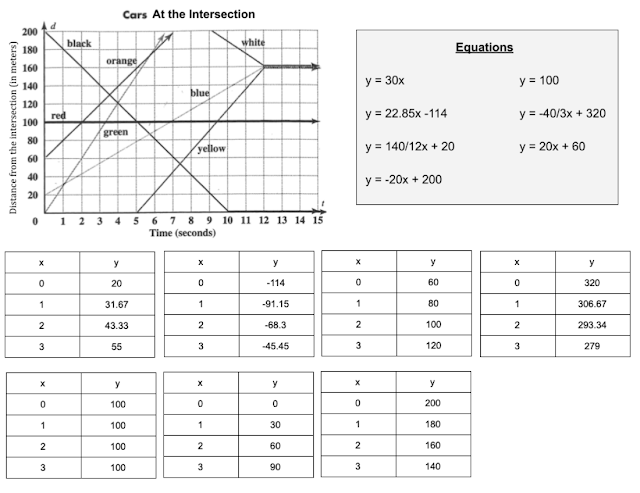Today, we combined consolidation with a thin-slicing activity!
More bang for the buck was my hope! :)
Background
For the last two weeks, we've been analyzing and communicating about the following graph.
Students started out by just pulling information from the graph and completing the chart below.
After consolidation on various aspects of the graph and chart,
We moved on to analyzing how the story can be represented in multiple ways.
In a story with words.
In a graph.
In a table.
And the most abstract of all, in an equation.
Students had worked a little bit with tables previous to this,And quickly caught on to which table matched each car's story.
This was the first time for equations to enter the picture as a way to communicate the story.
Because I only offered seven choices, students were able to connect the correct equation to each story.
(To ramp up the rigor, I could provide good distractors to the list.
This however, was not my goal for the lesson.
The goal for the lesson was for students to identify all pieces of the story (speed, starting point and direction) before I connect these concepts to their more abstract mathematical vocabulary (slope, y-intercept, and positive/negative slope).
4) Create a table for a car starting 10 m from the intersection, moving at 35 m/s.
Today, we looked at where the main pieces (speed, starting point, and direction)
Are found in each representation.
Highlighting each with a different shape and color.
After analyzing each format of the story,
Students worked in their groups (at their desks to avoid transfer time to the white boards)
And created equations or tables for various scenarios.
1) Create an equation for a car moving faster than the green car.
2) Write an equation for a car starting closer to the intersection than the orange car.
3) Create a table for a moving at 25 m/s
5) Write an equation for a car going in the opposite direction as the black car.
Since we weren't at the vertical white boards,
Students simply held up their individual board at each table
So everyone could see their work
And a mini conversation could be had over misconceptions or differences in the equations.
The thin-slicing of questions started off easy with a focus on the starting point,
Before moving on to speed,
Then direction,
Then combinations of the two or all three!
I love how these strategies can lend themselves into various outlets in the classroom.
While we all see the benefits of the vertical white boards,
The same concept can be implemented at tables to help save some class time.








No comments:
Post a Comment